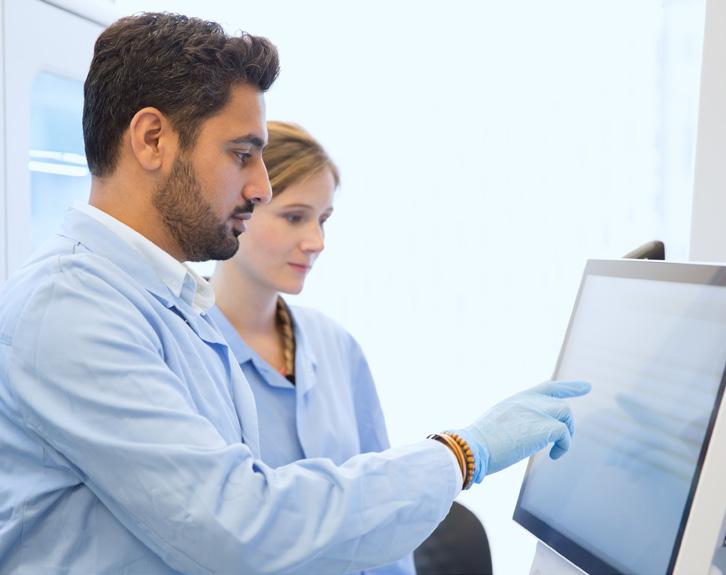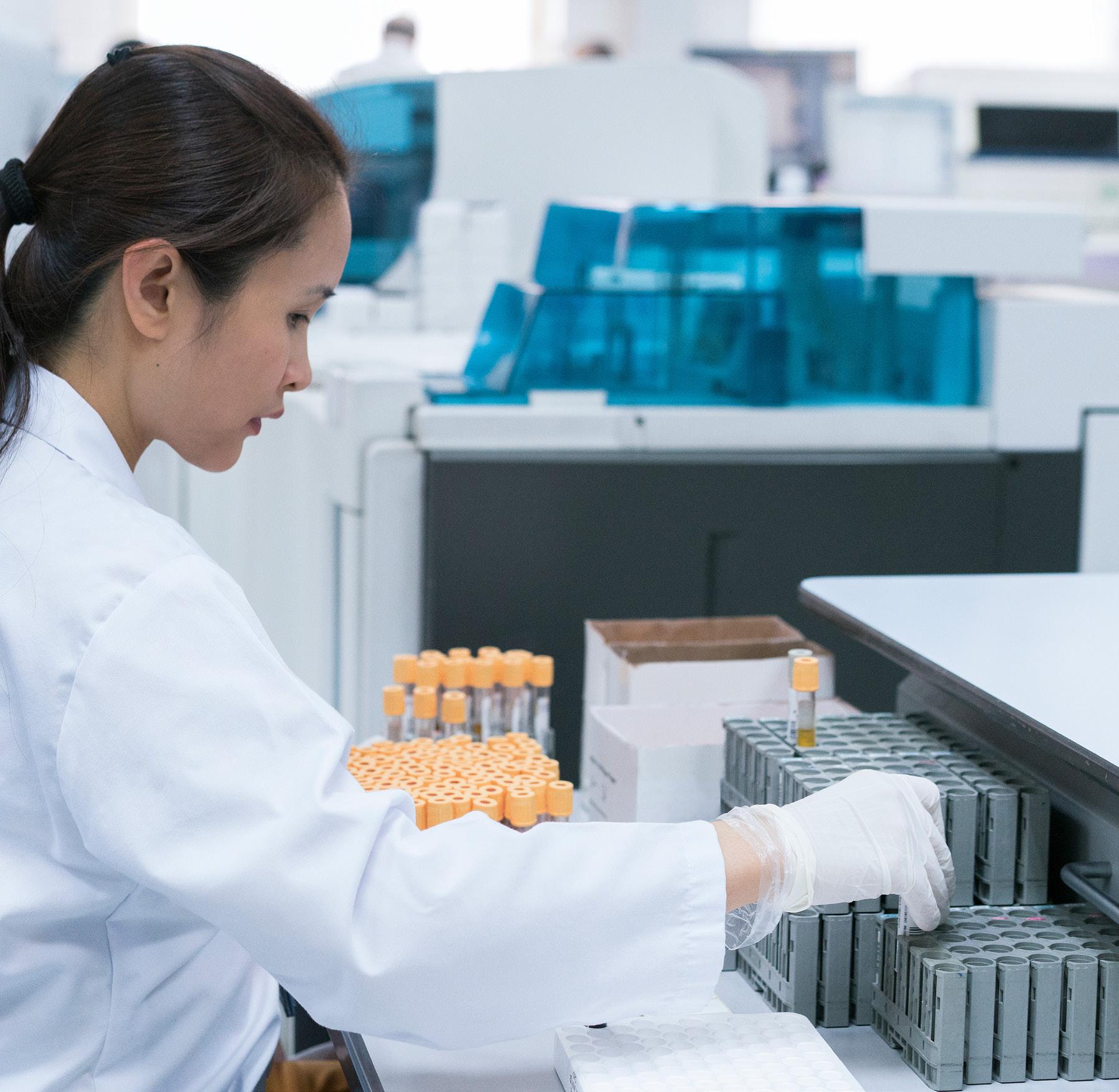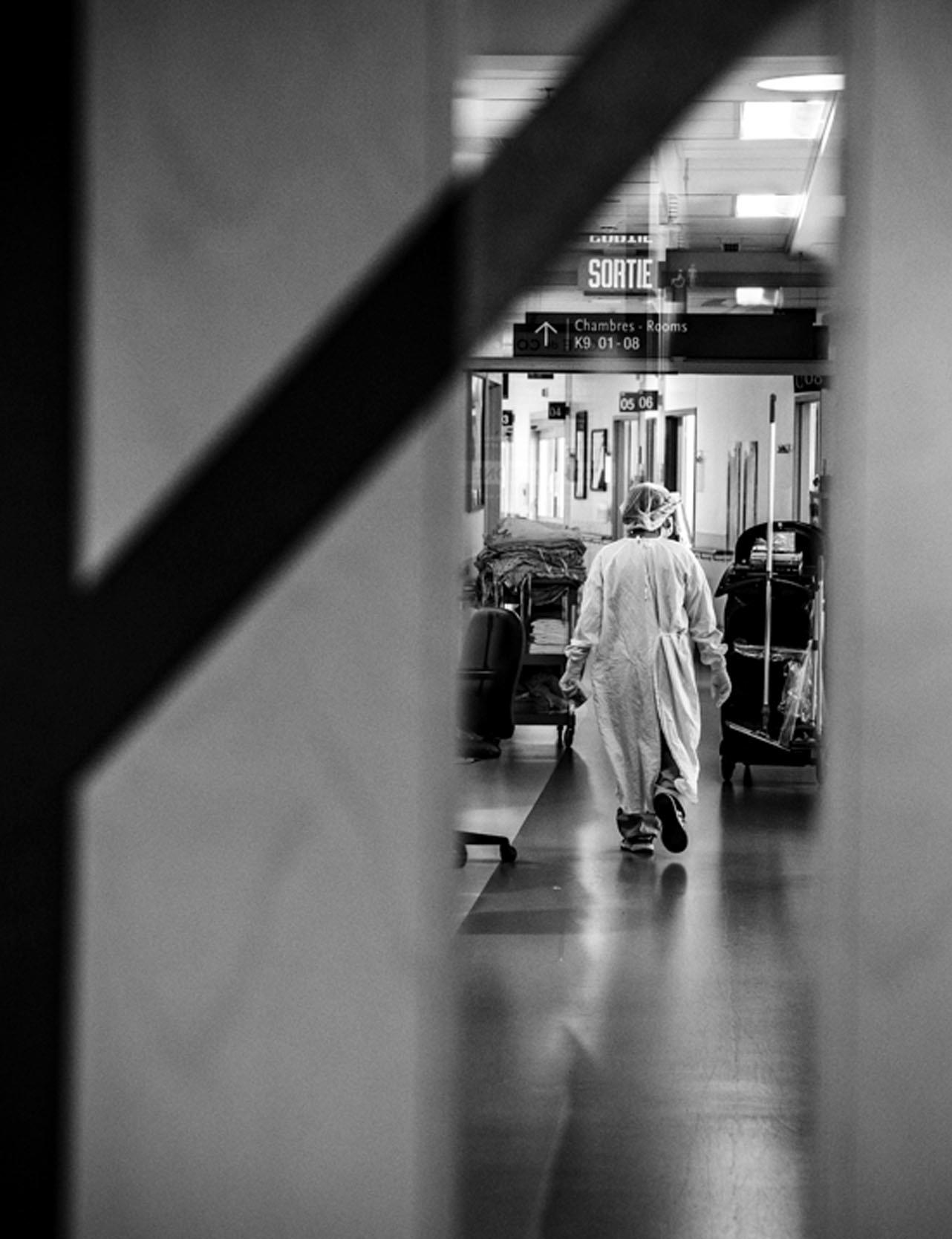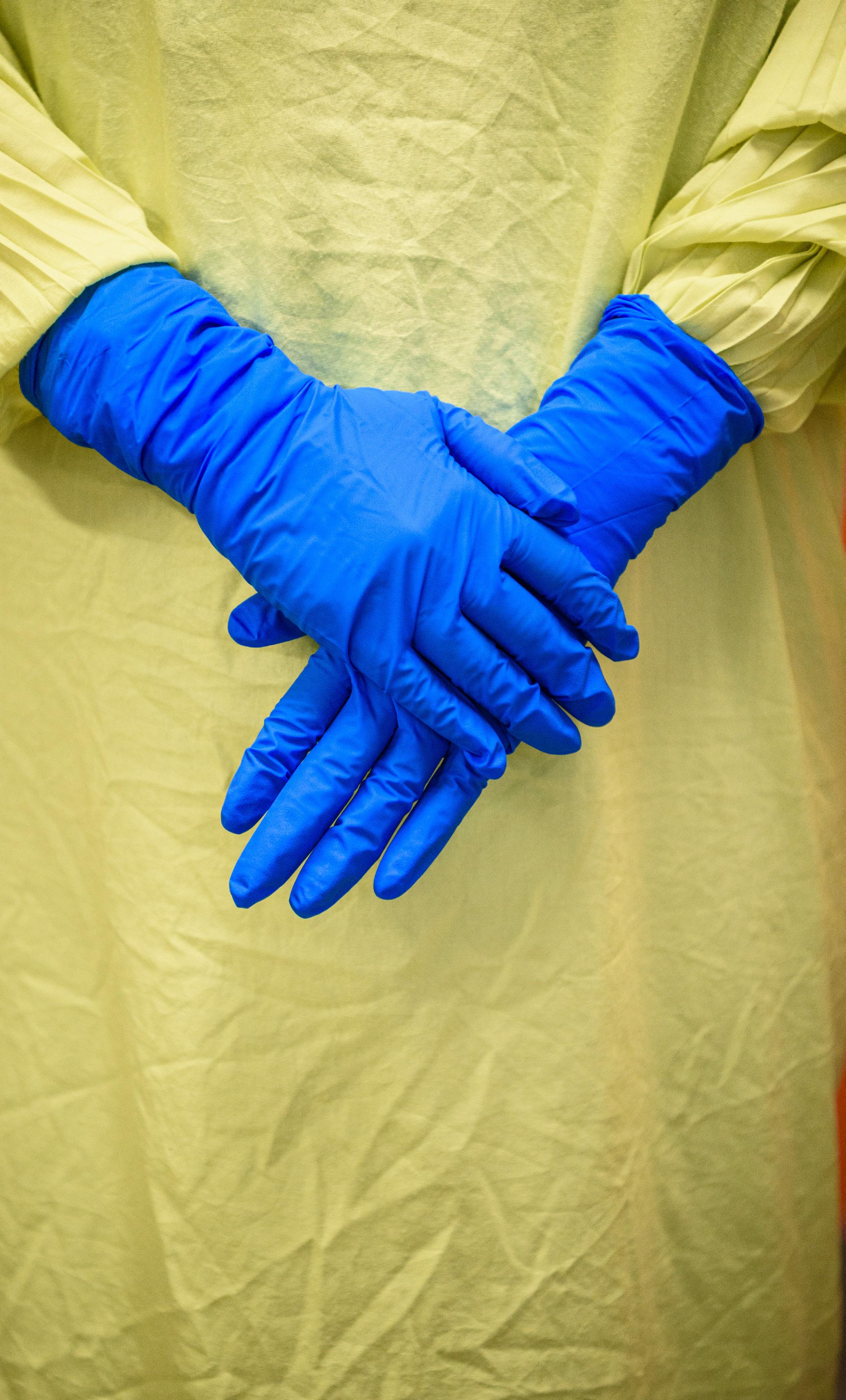Roche: Ushering in the golden era of diagnostics
Across the healthcare industry and especially on the back of the COVID-19 pandemic, the value of diagnostics is now undisputed. With tests that detect and monitor diseases, conditions, and infections, diagnostics are a critical part of a patient’s journey while informing and supporting about 70 percent of healthcare decisions.
As a key partner to the Jewish General Hospital (JGH), Roche is a pioneer in the field and a trusted partner and leader in the delivery of diagnostic and pharmaceutical solutions for over 125 years globally, and for over 90 years in Canada.

By leveraging the combined strengths of diagnostics and pharmaceuticals, Roche is dedicated to advancing science to improve people’s lives.
“With the purpose of Doing Now What Patients Need Next, Roche has a culture of going beyond the product and a tradition of looking to the past to develop innovative solutions that improve the present, but never at the expense of the future,” opens François Drolet, Executive Director, Access, Policy and Government Relations.
The company is on the cusp of reaching a new level of possibilities as diagnostics leverage the technological advances of artificial intelligence (AI), digital health and advanced data analytics, to realize its vision of personalised healthcare, ensuring that we can fit the right test and the right treatment, to the right patient at the right time.
“Diagnostics is the backbone of the healthcare system, and we are entering the golden era of diagnostics right now in terms of both technology and public knowledge,” continues Drolet.

A LEADING PARTNER
Roche’s partnerships are a testament to the company’s commitment to science, innovation and excellence in service, in and outside the laboratory.
This is evidenced by Roche’s ongoing partnership with the Jewish General Hospital, one of Quebec’s leading healthcare facilities and an early adopter of Roche’s core lab and molecular technologies making it a key player in a network of hospital-based clinical laboratories affiliated with McGill University (Optilab Montréal - MUHC).
“Our customers tell us that partnerships with Roche help them demonstrate the value of the lab to the hospital and the lab’s role in patient outcomes, which helps the lab improve access to novel high medical value tests for patients,” says Executive Director, Medical and Scientific Affairs at Roche, Michele D’Elia.
Roche Diagnostics’ innovation comes as a result of its relentless investments in R&D that accounts for more than its three major competitors combined. Lab automation is a key area of focus, providing critical resources in times of understaffing and exhaustion as witnessed during the COVID-19 pandemic.
At the Jewish General Hospital (JGH), Roche installed a fully automated molecular testing system that was instrumental in increasing the capacity of the province of Quebec’s COVID-19 testing network.


Medical leadership at the JGH attest to this solid partnership that continues to adapt and develop over time. For Dr. Jerry Zaharatos, Medical Microbiologist at the JGH, Roche’s installation of the cobas® 8800 instrument has expanded the hospital’s strengths in molecular microbiology and innovative testing measures.
“Before the arrival of the cobas® 8800, assuming ideal conditions, we were able to do under 800 tests a day. After its addition, we were able to provide between 2,000 to 3,000 test results per day,” he says. “Our workflow was streamlined, biosafety was optimized and we
gained significant efficiencies throughout the pre-analytical, analytical and post-analytical phases of testing.” Critically, the automated platform minimized potential for error by preserving limited human resources and reducing hands-on time and fatigue.
“We were also able to automate screening for SARS-CoV-2 variants of concern. With Roche’s assistance we were able to quickly adapt our screening strategy for new mutations using a laboratory developed test on the cobas® 8800’s open Omni-channel.”
“We went live with SARS-CoV-2 RT-PCR testing in April of 2021. In order to further automate our workflow, this was eventually complemented by a p512 pre-analytical instrument,” Zaharatos adds. Both partners anticipate the continuation of a fruitful working relationship, furthering the possibilities of molecular microbiology at the JGH. As the COVID-19 pandemic de-escalates, the cobas® 8800 may be utilized to expand the variety of pathogen specific tests with the expansion of the molecular lab.
“As we shift more of our tests to the automated molecular in vitro diagnostics milieu, we hope to continue to improve the quality of care for the patients we serve both in our hospital and in the community,” concludes Zaharatos.
DIAGNOSTICS: THE POWER OF KNOWING IN COVID-19 & BEYOND
Throughout the course of the pandemic, Roche has been at the forefront of investment in COVID-19 diagnostics, leading the way with PCR, antibody and rapid testing as well as the automated instruments that made it possible to undertake at the required scale. Diagnostics proved invaluable as outbreaks of the virus were identified thanks to the high-quality tests for SARS-CoV-2.
As is the case in every clinical situation that requires an intervention, diagnostic testing plays an important role in the management of the COVID-19 disease. Key biomarkers such as Interleukin-6 (IL-6) and procalcitonin (PCT) are used in intensive care units to respectively monitor the inflammatory response and diagnose bacterial infections in hospitalised patients. The information delivered by these biomarkers gives additional insights on the disease progression and allows clinicians to make informed and timely decisions. “The previously inconspicuous laboratory in the public sphere has come out of the shadows during the pandemic through its contribution, its value and the importance of test results - we call it: the power of knowing,” D’Elia affirms.
“Throughout the COVID-19 pandemic, it has been clear that access to a strong and diverse diagnostics infrastructure was crucial in tackling this enormous risk to healthcare and the global economy,” comments Drolet.
As the catalyst to introduce this revolution in diagnostics at the Roche laboratories, this has exposed a potential that the company intends to exploit well into the future of healthcare.
The true value of diagnostics laboratories is rising to the fore, with Roche at the vanguard in exploring their potential in cancer identification thanks to diagnostic test results, and a host of other infectious or chronic diseases and pathologies. The same instruments applied for COVID-19 testing are now performing other key molecular tests, such as human papillomavirus (HPV) and Chlamydia trachomatis/ Neisseria gonorrhoeae (CT/NG) testing.
“Just imagine if we were to look at these other life-threatening diseases and conditions in the same way - the good that could be done for people and for the system as a whole,” D’Elia adds.
Testing is an integral part of a patient’s journey, streamlining and improving communication between doctors and patients with requisition of tests based on that patient’s symptoms, paving the way for adequate medical advice and the appropriate targeted therapy.
ROCHE - BUILDING THE FUTURE
In the face of an ageing population with increasingly complex healthcare needs, the need to keep up to date with the everexpanding advances in technology and medicine, increasing patient expectations, and all against a backdrop of limited resources and the widespread impact and disruption of a global pandemic - diagnostics holds the answer.
“We at Roche, believe we have key solutions acting as fundamental pieces of the puzzle in tackling this ongoing healthcare crisis. We believe the starting point has to be prevention and early detection,” says D’Elia. “Tomorrow, I think it is going to be obvious to healthcare providers and patients that we can use these same tools to manage
other diseases in a different and more effective way. We have before us a new way of looking at the patient journey and assessing value in the healthcare system,” he surmises.
As diagnostics enters the realm of public consciousness like never before, Roche is creating a connected care pathway for patients that encourages the integration of innovative solutions that simplify patient care, lift the burden from the shoulders of the healthcare system, and ultimately – save lives.

As Drolet affirms, “Through better diagnostics, we can seize this moment to build a future where every Canadian has access to the right care, at the right time, and in the right place.”
rochecanada.com
cardiac catheterization laboratory and the various clinics.
“In addition, we have had to redefine patient pathways, including admission, transfers and discharges,” Dr.
JGH – VISION, MISSION, VALUES
The vision of the institution is “Care Everywhere” – that is, providing care in whichever setting is safest, most convenient, and most comfortable for the patient.
JGH VALUES:
A. Highest Quality of Care: The JGH values excellence and is committed to providing the highest evidence-based quality of care for all.
B. Compassion, Dignity and Respect: An exceptional user experience is the JGH’s goal.
C. Safety: The JGH is committed to providing care and services within a safe and secure environment. This is a shared responsibility.
D. Teamwork: The JGH recognizes and acknowledges the important contributions of each member of its staff and partners.
E. Knowledge Creation and Innovation: The JGH values excellence in teaching and research, which leads to the very best quality of care. The organization encourages creativity and initiative in its staff, so that they can identify and implement innovative ways to enhance the care and services that the JGH provides.
The JGH’s mission is to provide value-based, patient-driven care that puts a premium on the user experience, while at the same time empowering the JGH’s care providers to take collective responsibility by using a “team of teams” approach.
Rosenberg explains. “We have greatly increased extensive training in the use of personal protective equipment (PPE), with support from our Infection Prevention and Control team, so that we can function effectively in a pandemic environment.
“As the first wave of the pandemic rolled on, the hospital engaged in a very significant transfer of staff among our CIUSSS’s facilities, so that support could be provided to the COVID-19 units that had been set up.
“Telehealth, which had been in its preparatory stages before the pandemic struck – as part of the hospital’s very aggressive strategic plan for digital transformation –was rapidly rolled out to support patients and their families. Most of our ambulatory clinics established telehealth capabilities, and the cancer center, in particular, was able to maintain up to 85 percent of its usual activity through telehealth technologies.”
At the same time, the JGH established a digital command center to proactively manage beds and patient flow across the hospital and the rest of the CIUSSS. The command center was underpinned by artificial intelligence (AI) modelling, which permitted the JGH to predict COVID-19 hospitalizations one week in advance, with an outstanding accuracy rate of nearly 97 percent. As a result, the JGH was able to plan bed capacity and staffing, while ensuring an adequate supply of PPEs in the right places at the right time.
R&D
This type of support is intrinsic to the nature of the JGH as a medical institution, extending into the area of medical education and training, as well as research and development. The hospital’s principal R&D facility is the Lady Davis Institute for Medical Research (LDI), whose researchers have cross-appointments and strong connections to McGill University.
GE Healthcare
GE Healthcare has been honored to work with the leaders and frontline heroes at the Jewish General Hospital (JGH), as a long-term partner committed to a shared goal of leveraging innovation to deliver world-class patient care. JGH has long been recognized as a leading Healthcare provider both in Canada, and globally, due to their focus on delivering patient care of the highest quality. Further, JGH consistently leverage advanced technologies as they strive to deliver clinical excellence.
In collaboration with JGH, we continue to focus successfully on reducing patient backlogs, optimizing patient care, and enhancing operational efficiency. Like JGH, our commitment to customers can be felt both globally and locally though our technologies and solutions with a devoted local Applications and Service team.
Our GEHC ecosystem delivers precision health: digitizing healthcare and driving productivity to improve outcomes for patients, providers, health systems, and researchers around the world. As a leading global medical technology, pharmaceutical diagnostics, and digital solutions innovator, we enable clinicians to make faster, more informed decisions through intelligent devices, data analytics, applications, and services, supported by our Edison intelligence platform. We are committed to fostering an inclusive culture of respect, transparency, and unyielding integrity.
Today, we are actively working on cutting edge solutions in cardiology, medical imaging, and critical care. We are also proud to share that JGH is using the GEHC Centricity High Acuity Care Solution to address surgical backlogs and increase OR performance. Moving forward, emerging challenges will bring further opportunities to work together to drive innovative patient centered solutions. We are grateful to be part of the patients’ journey with the JGH in moments that matter.
www.gehealthcare.ca
8 | Healthcare Outlook Issue 2 JEWISH GENERAL HOSPITAL NORTH AMERICA

Since opening in 1967, the LDI has been at the forefront of health research, becoming one of the premier research institutes in Canada. “In the early 1980s, Dr. Mark Wainberg conducted pioneering work on the global HIV/AIDS pandemic, leading to the discovery of the anti-viral drug 3TC (Lamivudine) in 1989,” Dr. Rosenberg elaborates. “This drug is still used in combination with other medications to treat infections caused by HIV.
“During the COVID-19 pandemic, Dr. Brent Richards of the LDI has been prominent in gaining an understanding of the genetic risk for COVID-19 and establishing genetic predictors for the severity of the disease.
“As we emerge from this pandemic, the LDI will continue to expand its research focus on emerging infectious diseases, informed by our clinical experience at the JGH, one of the

busiest infectious disease hospitals in Quebec and Canada.”
As well, the LDI has been at the forefront of mental health research, with Dr. Laurence Kirmayer’s pioneering achievements in cultural psychiatry, and Dr. Brett Thombs’ work in screening for depression in his international, collaborative DEPRESSED PROJECT. The continued focus on mental health is essential as society rebounds from the COVID-19 pandemic.
LDI’S EPIDEMIOLOGY CENTER
According to Dr. Rosenberg, the LDI’s Center for Clinical Epidemiology, led by Dr. Samy Suissa, plays a central role in assessing, monitoring and improving healthcare interventions. To do so, it relies on its leaders in pharmaco-epidemiology, which involves studying the risks and benefits of medications in the realworld conditions of clinical practice.
ADSS
As a Security Systems Integrator, ADSS continues to be involved in several projects and renovations for the Jewish General Hospital.
At the beginning of the pandemic, we assisted in the construction of one of the first COVID-19 test centers in Montreal. Due to the unprecedented urgency, most of the technical teams worked tirelessly, allowing the center to open several days ahead of schedule.
We remained onsite until the last minute and witnessed the many healthcare workers waiting to receive and test patients for this new potentially deadly virus. Our healthcare workers are the epitome of courage, and we are humbled to have been able to support them with this undertaking.
www.adss.ca
KARL STORZ
Since its beginnings in 1945, the KARL STORZ family company has grown into a global manufacturer and distributor of endoscopes, medical instruments, and devices.
We are no giant on an international scale but a leader in the things that matter: creativity, flexibility, and expertise.
Our KARL STORZ NEO IP modular integration system is built around a fiber optic IP based solution. This backbone allows us to provide you with a state-of-the-art integration platform to meet your needs today while giving you the flexibility to add new technologies in the future.
T 905-816-4500
E Info-Canada@karlstorz.com
www.karlstorz.com
“THE CONTINUED FOCUS ON MENTAL HEALTH IS ESSENTIAL AS WE REBOUND FROM THE COVID-19 PANDEMIC”
10 | Healthcare Outlook Issue 2 JEWISH GENERAL HOSPITAL NORTH AMERICA
– DR. LAWRENCE ROSENBERG, PRESIDENT AND CEO, JEWISH GENERAL HOSPITAL




SECURITY SYSTEMS INTEGRATOR Your security is our business We offer tailor made electronic security solutions with top-of-the-line products, installed and serviced by a team of experienced professionals. Our experience, competence and focus will deliver client satisfaction. Our service is exemplary, with well-trained technicians who provide professional installation, maintenance and service support. We work with you to implement your custom solution that will best suit your organizational needs. Atlantic – Montreal – Ottawa - Toronto | T 844-768-2377 | info@adss.ca | www.adss.ca Healthcare Outlook Issue 2 | 11 JEWISH GENERAL HOSPITAL NORTH AMERICA Adaptable By Design We ADAPT to the needs of our customers by creating a DESIGN that is ergonomic, scalable, upgradeable, and modular. Contact Info: PH: 905-816-4500 / Website: www.karlstorz.com / Email: Info-Canada@karlstorz.com 97207021 OR1 2 1.0 cae 02/2022/A-E-CAE
This has led to the development of new research and the extensive publication of articles about methods of accomplishing more rapid and accurate assessments of drug safety and effectiveness. Over the past 10 years, analysis of the data has been conducted by the Canadian Network for Observational Drug Effects Studies (CNODES), which is based at the LDI. CNODES includes a panCanadian team of scientists who draw on provincial healthcare databases to evaluate the effects of medications used by Canadians.
“This vision will now be expanded to include the development of our Centre for Digital Health and Applied Precision Medicine,” Dr. Rosenberg continues. “Its program will include the entire spectrum of research: basic research, including target identification and molecular pharmacology; prevention through the identification of diseasesusceptibility genes and pathogenetic mechanisms; translational clinical research that specializes in clinical trials that incorporate correlation studies based on patient-derived bio specimens; and lastly, the identification of epidemiological and psychosocial contributors to health and illness.
“The focus will be on a bench-tobedside-to-community approach. We aim to capture an Evolving Digital
Patient Passport that will incorporate diverse datasets, including genomics data, epigenetic data, microbiome data combined with socio-economic data, clinical data and environment exposure data to personalize our approaches to human health and disease.”
This patient passport will evolve over time in the form of a “learning health journey”. With the changing demographics of Canada’s aging population, the JGH recognizes that most people will be living with multiple chronic diseases. Therefore, a focus on the early diagnosis of chronic diseases will be essential in improving the health of its patient populations.
“This will include an emphasis on innovative technologies, such as wearables and liquid biopsies,” Dr. Rosenberg says. “Can you imagine the day where an annual blood sample will be able to screen for early onset cancer, cardiovascular disease, and autoimmune diseases such as rheumatoid arthritis and diabetes? The change in focus to early diagnosis represents an inflection point that could change the course of the chronic disease trajectory and have major health benefits for society.”
HOSPITAL REBUILD – PHASE ONE

The JGH has also invested significantly in better patient care
by building a new critical-care wing, known as Pavilion K, a project that has been implemented in three phases to date. The fourth and final phase, renovation of the legacy building, is soon to get under way. The Pavilion K project was named the 2017 PMI (Project Management Institute) Project of the Year (Elixir Competition).
Phase one was the launch of the new JGH Emergency Department (ED) in 2014. Between 2010 and 2014, the ED team pursued an innovative design that followed the adage, “form follows function”. Members of the team visited new EDs across Canada and the US, while contacting top ED architects and conceptual ED innovators in North America. A peripheral entry, linear pod design, was retained and married to the splitflow concept of ED patient flow.
“For many years, the JGH’s ED had been the busiest in Quebec,” Dr. Rosenberg tells us. “This occurred in the years that followed SARS and H1N1, and thus, preventive isolation issues remained at the forefront of the hospital’s concerns. This preoccupation resulted in a design consisting mostly of individualized patient examination rooms, with true ceilings, individualized ventilation and many negative pressure rooms in the pods. There was also a pressing need to manage the volume within the constraints of the designated space for the ED.
“Historically, the ED was an exceedingly noisy, stressful area where staff retention and the safe care of patients were preoccupying issues. This prompted us to implement an innovative design and use special materials to decrease the impact of noise. The ED became the first in Quebec to have a designated Rapid Assessment Zone (RAZ), the split-flow concept, peripheral entry for families, a linear pod design, and – somewhat presciently – an ED designed to handle a sudden influx
12 | Healthcare Outlook Issue 2 JEWISH GENERAL HOSPITAL NORTH AMERICA
The Eyes of the Pandemic. Some personal portraits of our frontline workers during the pandemic
Made for today, tomorrow and for what’s needed next
Anticipating your needs is how we help you and the world of health stay ahead. For 125 years, BD has known one thing to be true – for health care professionals to be at their best, they need the best. That’s why we’re continually advancing the quality of care delivery by pioneering new technologies that address healthcare’s most pressing needs, often before they arise.



bd.com/en-ca
bd.com/fr-ca

Healthcare Outlook Issue 2 | 13 JEWISH GENERAL HOSPITAL NORTH AMERICA
of infectious patients in case of a pandemic crisis. Since then, these concepts have spread to the planning of other new EDs in Quebec. The JGH’s ED remains the busiest in the province, with close to 95,000 visits annually, prior to COVID-19.”

HOSPITAL REBUILD – PHASES TWO AND THREE
Phases two and three were designed to deliver on the promise of a “healing environment” on the nursing units and in all of the critical care areas, centered around the needs of patients and their families, and the requirements of medical professionals. Moreover, four clinical programs were completely reimagined to produce two units with integrated care trajectories based on the integrated practice unit (IPU) model. These were the Cardiovascular IPU (Cardiology, Cardiac Surgery, CVICU) and the Neurosciences IPU (co-localizing Neurology and Neurosurgery to provide an intermediate level of
“RECRUITMENT AND EMPLOYEE WELLBEING WILL ALSO REMAIN A KEY PART OF OUR FOCUS MOVING FORWARD, TO ENSURE THAT MEMBERS OF OUR STAFF FEEL THEY ARE BEING WELL SUPPORTED IN THE INCREASINGLY BUSY DECADE THAT LIES
care, including a state-of-the-art rehabilitation room).
“A particularly noteworthy feature of the new pavilion resulted from intentional planning back in 2010: This was the design of a dedicated pandemic ward, the first of its kind for any new expansion project in a hospital in Quebec,” Dr. Rosenberg explains. “Our experience with H1N1 in 2009 raised questions about our preparedness for future pandemics. As a consequence, during the early design phase of Pavilion K, we incorporated a 24-bed unit, in
which all rooms are single-bedded, equipped with negative pressure ventilation and including negative pressure antechambers.
“In addition, each nursing unit in Pavilion K is equipped with a certain number of negative pressure rooms –with and without antechambers – to accommodate additional patients requiring isolation. Accordingly, the JGH was designated as Montreal’s first adult COVID-19 site during the first wave of the pandemic, when as many as 176 COVID-19 patients were admitted at the peak.”
AHEAD”
14 | Healthcare Outlook Issue 2
– DR. LAWRENCE ROSENBERG, PRESIDENT AND CEO, JEWISH GENERAL HOSPITAL
STERILIZATION AND SUSTAINABILITY
Pavilion K’s operating rooms (OR) were designed to prioritize strict infection control and to optimize the flows of patients and materials. The stand-out features include a direct link with sterilization (elevators for clean and soiled items); a sterile core, with automated dispensing cabinets; case cart trajectories; pre- and postoperative patient flows, previously mapped out using RFID; a dedicated robotic surgery theater, and a hybrid robotic room, enabling cardiac surgeons and cardiologists to work together concurrently.
“Special mention must also be made of the use of DMI machines in the sterile core,” Dr. Rosenberg adds. “These are automated dispensing machines, tracked by dedicated software in real time, that require no human interaction. Their installation has permitted us to have 100 percent control of ophthalmology lenses, including use by specific surgeons. This has enabled us to track the type of lens implanted into which patient, thereby reducing costs and theft.”
Furthermore, the Sterilization Department was renovated in 2016 and remains to this day a showcase of best practice for hospitals in Quebec. With Pavilion K, the JGH has been able to centralize all sterilization activities across its 34 sites. All of the norms of

the Canadian Standards Association (CSA) are respected, and the JGH has had 100 percent compliance, as documented in four accreditations in a row.
“Lastly, we would like to draw attention to the important green issue of energy saving and sustainable development (ESSD),” Dr. Rosenberg says. “An $18.8 million ESSD project is now under way, with more than 85 percent of the measures completed. Ultimately, savings are estimated at $1.3 million per year. The project focuses on traditional energy management measures, but will also ensure the development of more ambitious and innovative measures, such as the installation of an aerothermal system to supplement the heating network of the JGH.”
DIGITAL HEALTH
analysis,” Dr. Rosenberg notes. “Virtual care will also be a focal point of our future activities, and we will scale up our COVID@HOME program to a full HOSPITAL@HOME program.”
Of key importance is OROT (“illumination” in Hebrew), the CIUSSS’s connected health innovation hub which is based at the JGH. OROT is bringing together healthcare professionals and privateHealthcare entrepreneurs to better understand the needs of healthcare users, co-develop prototypes, and integrate and commercialize the next generation of digital innovation. In a broader sense, Dr. Rosenberg explains, OROT is challenging its participants to do nothing less than “re-imagine the future of healthcare networks,” but always with an eye toward human-centered design.
JGH, a member facility of the West-Central Montreal Health Authority (CIUSSS), have pioneered the first application of the Microsoft HoloLens for use in real-time, extended reality (XR) clinical support of a minimally invasive heart procedure.

Looking forward, the JGH will continue to implement its digital health strategic plan, including its Connected Health Record, a nextgeneration electronic health record (EHR) under co-development; expanding data analytics and the data science portfolio with an international partner; introducing digital assistants – for example chatbots –to facilitate user interaction and experience.
“We will expand the operations of our command center to include AI-based modelling and data
“Recruitment and employee wellbeing will remain a key part of our focus moving forward,” Dr. Rosenberg adds. “This will ensure that members of our staff feel they are being well supported in the increasingly busy decade that lies ahead.”
JEWISH GENERAL HOSPITAL
Tel: 514-340-8222
communications@jgh.mcgill.ca
www.jgh.ca
Discover Our New Energy Efficient Project
Healthcare Outlook Issue 2 | 15 JEWISH GENERAL HOSPITAL NORTH AMERICA
JEWISH GENERAL HOSPITAL

3755 Côte-Sainte-Catherine Road
Montréal, Québec, Canada
H3T 1E2
Tel: 514-340-8222
communications@jgh.mcgill.ca
www.jgh.ca
PRODUCED BY HEALTHCARE OUTLOOK MAGAZINE




 Writer: Jack Salter | Project Manager: Felix Revell
Writer: Jack Salter | Project Manager: Felix Revell



















